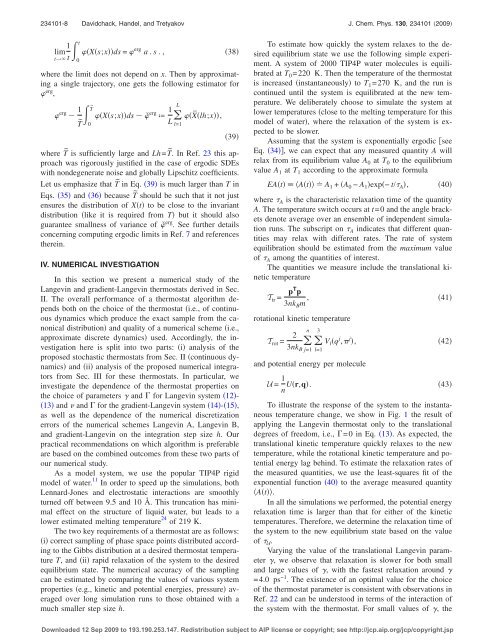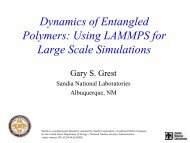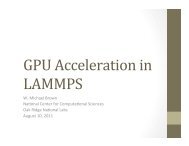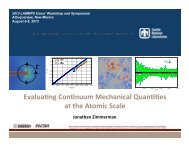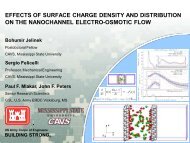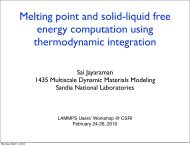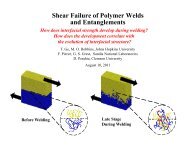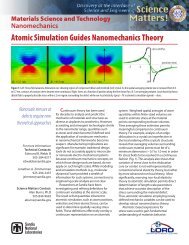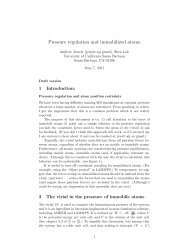Langevin thermostat for rigid body dynamics - Lammps
Langevin thermostat for rigid body dynamics - Lammps
Langevin thermostat for rigid body dynamics - Lammps
Create successful ePaper yourself
Turn your PDF publications into a flip-book with our unique Google optimized e-Paper software.
234101-8 Davidchack, Handel, and Tretyakov J. Chem. Phys. 130, 234101 2009<br />
1<br />
lim<br />
t<br />
t→ t0<br />
Xs;xds = erg a . s .,<br />
38<br />
where the limit does not depend on x. Then by approximating<br />
a single trajectory, one gets the following estimator <strong>for</strong><br />
erg ,<br />
erg 1 T˜0<br />
˜<br />
T<br />
Xs;xds ˇ erg ª 1 X¯ lh;x,<br />
L l=1<br />
39<br />
where T˜ is sufficiently large and Lh=T˜. In Ref. 23 this approach<br />
was rigorously justified in the case of ergodic SDEs<br />
with nondegenerate noise and globally Lipschitz coefficients.<br />
Let us emphasize that T˜ in Eq. 39 is much larger than T in<br />
Eqs. 35 and 36 because T˜ should be such that it not just<br />
ensures the distribution of Xt to be close to the invariant<br />
distribution like it is required from T but it should also<br />
guarantee smallness of variance of ˇ erg . See further details<br />
concerning computing ergodic limits in Ref. 7 and references<br />
therein.<br />
IV. NUMERICAL INVESTIGATION<br />
In this section we present a numerical study of the<br />
<strong>Langevin</strong> and gradient-<strong>Langevin</strong> <strong>thermostat</strong>s derived in Sec.<br />
II. The overall per<strong>for</strong>mance of a <strong>thermostat</strong> algorithm depends<br />
both on the choice of the <strong>thermostat</strong> i.e., of continuous<br />
<strong>dynamics</strong> which produce the exact sample from the canonical<br />
distribution and quality of a numerical scheme i.e.,<br />
approximate discrete <strong>dynamics</strong> used. Accordingly, the investigation<br />
here is split into two parts: i analysis of the<br />
proposed stochastic <strong>thermostat</strong>s from Sec. II continuous <strong>dynamics</strong><br />
and ii analysis of the proposed numerical integrators<br />
from Sec. III <strong>for</strong> these <strong>thermostat</strong>s. In particular, we<br />
investigate the dependence of the <strong>thermostat</strong> properties on<br />
the choice of parameters and <strong>for</strong> <strong>Langevin</strong> system 12-<br />
13 and and <strong>for</strong> the gradient-<strong>Langevin</strong> system 14-15,<br />
as well as the dependence of the numerical discretization<br />
errors of the numerical schemes <strong>Langevin</strong> A, <strong>Langevin</strong> B,<br />
and gradient-<strong>Langevin</strong> on the integration step size h. Our<br />
practical recommendations on which algorithm is preferable<br />
are based on the combined outcomes from these two parts of<br />
our numerical study.<br />
As a model system, we use the popular TIP4P <strong>rigid</strong><br />
model of water. 11 In order to speed up the simulations, both<br />
Lennard-Jones and electrostatic interactions are smoothly<br />
turned off between 9.5 and 10 Å. This truncation has minimal<br />
effect on the structure of liquid water, but leads to a<br />
lower estimated melting temperature 24 of 219 K.<br />
The two key requirements of a <strong>thermostat</strong> are as follows:<br />
i correct sampling of phase space points distributed according<br />
to the Gibbs distribution at a desired <strong>thermostat</strong> temperature<br />
T, and ii rapid relaxation of the system to the desired<br />
equilibrium state. The numerical accuracy of the sampling<br />
can be estimated by comparing the values of various system<br />
properties e.g., kinetic and potential energies, pressure averaged<br />
over long simulation runs to those obtained with a<br />
much smaller step size h.<br />
L<br />
To estimate how quickly the system relaxes to the desired<br />
equilibrium state we use the following simple experiment.<br />
A system of 2000 TIP4P water molecules is equilibrated<br />
at T 0 =220 K. Then the temperature of the <strong>thermostat</strong><br />
is increased instantaneously to T 1 =270 K, and the run is<br />
continued until the system is equilibrated at the new temperature.<br />
We deliberately choose to simulate the system at<br />
lower temperatures close to the melting temperature <strong>for</strong> this<br />
model of water, where the relaxation of the system is expected<br />
to be slower.<br />
Assuming that the system is exponentially ergodic see<br />
Eq. 34, we can expect that any measured quantity A will<br />
relax from its equilibrium value A 0 at T 0 to the equilibrium<br />
value A 1 at T 1 according to the approximate <strong>for</strong>mula<br />
EAtAt A 1 + A 0 − A 1 exp− t/ A , 40<br />
where A is the characteristic relaxation time of the quantity<br />
A. The temperature switch occurs at t=0 and the angle brackets<br />
denote average over an ensemble of independent simulation<br />
runs. The subscript on A indicates that different quantities<br />
may relax with different rates. The rate of system<br />
equilibration should be estimated from the maximum value<br />
of A among the quantities of interest.<br />
The quantities we measure include the translational kinetic<br />
temperature<br />
T tr =<br />
pT p<br />
3nk B m ,<br />
rotational kinetic temperature<br />
T rot = 2<br />
3nk B<br />
<br />
n 3<br />
<br />
l=1<br />
j=1<br />
V l q j , j ,<br />
and potential energy per molecule<br />
U = 1 n Ur,q.<br />
41<br />
42<br />
43<br />
To illustrate the response of the system to the instantaneous<br />
temperature change, we show in Fig. 1 the result of<br />
applying the <strong>Langevin</strong> <strong>thermostat</strong> only to the translational<br />
degrees of freedom, i.e., =0 in Eq. 13. As expected, the<br />
translational kinetic temperature quickly relaxes to the new<br />
temperature, while the rotational kinetic temperature and potential<br />
energy lag behind. To estimate the relaxation rates of<br />
the measured quantities, we use the least-squares fit of the<br />
exponential function 40 to the average measured quantity<br />
At.<br />
In all the simulations we per<strong>for</strong>med, the potential energy<br />
relaxation time is larger than that <strong>for</strong> either of the kinetic<br />
temperatures. There<strong>for</strong>e, we determine the relaxation time of<br />
the system to the new equilibrium state based on the value<br />
of U .<br />
Varying the value of the translational <strong>Langevin</strong> parameter<br />
, we observe that relaxation is slower <strong>for</strong> both small<br />
and large values of , with the fastest relaxation around <br />
=4.0 ps −1 . The existence of an optimal value <strong>for</strong> the choice<br />
of the <strong>thermostat</strong> parameter is consistent with observations in<br />
Ref. 22 and can be understood in terms of the interaction of<br />
the system with the <strong>thermostat</strong>. For small values of , the<br />
Downloaded 12 Sep 2009 to 193.190.253.147. Redistribution subject to AIP license or copyright; see http://jcp.aip.org/jcp/copyright.jsp


